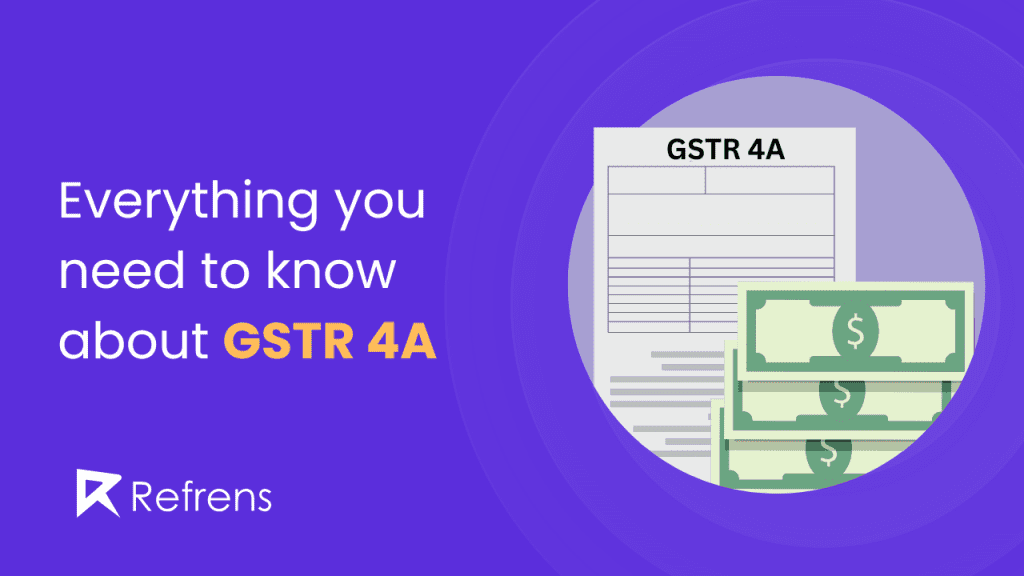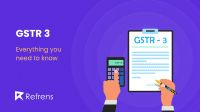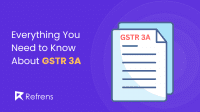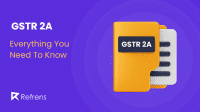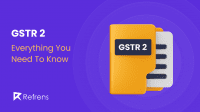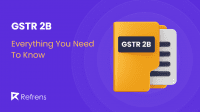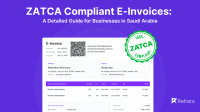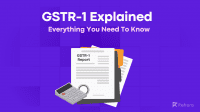GSTR-4A is an auto-generated, read-only form designed for composition taxpayers under the GST system. It contains details about all purchase-related transactions made by a composition dealer during a specific tax period. The data in GSTR-4A is automatically pulled from various supplier returns like GSTR-1, GSTR-5, and GSTR-7, giving composition dealers a complete and updated view of their taxable purchases.
Although taxpayers cannot edit or file GSTR-4A directly, it plays a key role in preparing the annual GSTR-4 return. By reviewing the GSTR-4A form, composition taxpayers can verify that their purchase records match the information provided by suppliers. This helps ensure smoother tax filing and full compliance with GST regulations.
Who are Composition Taxpayers?
Composition taxpayers are small businesses that have opted for the GST Composition Scheme. This scheme is available to businesses with an annual turnover of up to a specified threshold (typically ₹1.5 crore) and offers simplified tax filing processes. Instead of paying GST at regular rates, composition taxpayers pay tax at a lower, fixed rate based on their turnover. However, they cannot collect GST from their customers or claim input tax credits.
This blog provides a comprehensive guide on how to access, understand, and use GSTR-4A for smooth tax compliance.
What is GSTR-4A?
GSTR-4A is an auto-drafted, view-only return designed for composition taxpayers under the GST system. It serves as a summary of all the purchase-related transactions made by the composition dealer, capturing inward supplies from registered suppliers. This form is automatically generated by the GSTN (Goods and Services Tax Network) based on the data submitted by suppliers in their GSTR-1, GSTR-5, and GSTR-7 returns.
The primary purpose of GSTR-4A is to give composition taxpayers a clear view of their inward supply data, helping them prepare for their annual GSTR-4 filing. Since GSTR-4A is auto-populated, composition dealers cannot edit it directly. However, it acts as a critical tool to cross-verify the accuracy of purchase details entered by suppliers, ensuring there are no discrepancies when filing GSTR-4.
GSTR-4A is updated in real-time as suppliers file their returns, allowing composition dealers to monitor their transactions throughout the year. This feature ensures transparency and facilitates easier compliance with GST regulations.
Detailed Viewing of GSTR-4A and When to Review
GSTR-4A is an auto-drafted form generated for composition taxpayers, containing detailed information about inward supplies received from registered suppliers. It pulls data from supplier returns such as GSTR-1, GSTR-5, and GSTR-7, and is crucial for preparing the annual GSTR-4 return.
Sections of GSTR-4A
- B2B Invoices (Section 3A, 3B):
- This section captures Business-to-Business (B2B) invoices from registered suppliers. It includes the supplier’s GSTIN, invoice number, taxable value, GST rates (CGST, SGST, IGST, or Cess), and total tax payable.
- Cross-check this section with your purchase records to ensure all inward supplies are accurately reflected.
- Credit/Debit Notes (Section 4):
- Displays credit and debit notes issued by suppliers. Credit notes indicate a reduction in the taxable value or tax, while debit notes show an increase.
- Review the supplier’s GSTIN, reference invoice, and adjustments made to taxable values and taxes to ensure the correct amounts are applied.
- Amendments to B2B Invoices:
- Reflects any changes or corrections made by suppliers to previously filed B2B invoices. This could include updates to invoice numbers, taxable amounts, or GST rates.
- Verify the amendments and ensure your purchase records are up-to-date.
- Amendments to Credit/Debit Notes:
- Similar to B2B invoices, this section shows corrections made to previously issued credit or debit notes.
- Confirm that all adjustments are accurately reflected in your records.
When to Review GSTR-4A
- After Supplier Filing: GSTR-4A is updated in real-time as suppliers file their GSTR-1, GSTR-5, or GSTR-7 returns. Regularly monitor these updates to track accurate reporting of your inward supplies.
- Before Filing GSTR-4: Thoroughly review GSTR-4A before filing your annual GSTR-4 return to ensure completeness and accuracy.
- Quarterly Review: Conduct a quarterly review to catch any missing or incorrect entries early, allowing ample time for corrections.
- After Supplier Amendments: If a supplier files late or makes amendments, review GSTR-4A for the updated information to keep your records aligned.
By regularly reviewing the sections of GSTR-4A, composition taxpayers can ensure that all transactions, adjustments, and amendments are accurately captured, reducing the risk of discrepancies in their GSTR-4 return.
How to View GSTR-4A on the GST Portal
Follow these steps to access and review GSTR-4A on the GST portal:
- Log in to the GST Portal: Go to www.gst.gov.in and log in using your username and password.
- Navigate to Returns Dashboard: Under the “Services” menu, select “Returns” and click on “Returns Dashboard.”
- Select Financial Year and Tax Period: Choose the relevant financial year and tax period (e.g., Q1 2023-24).
- Search for GSTR-4A: Click “Search” to load the returns for the selected period and find GSTR-4A.
- View or Download GSTR-4A: You can view GSTR-4A online or download it in Excel format for offline review.
- Review the Details: Carefully examine each section (B2B invoices, credit/debit notes, amendments) to ensure all data matches your records.
This streamlined approach helps maintain accurate records and ensures smooth filing of your GSTR-4 return.
Quick Summary
GSTR-4A is a crucial auto-drafted form for composition taxpayers that helps in tracking inward supplies from registered suppliers. It is generated based on the data submitted by suppliers in their respective returns, such as GSTR-1, GSTR-5, and GSTR-7. Though GSTR-4A is a view-only document, it plays an important role in ensuring accuracy in the GSTR-4 filing process.
Here are the key points to remember about GSTR-4A:
- Purpose: GSTR-4A provides a summary of all purchase-related transactions and helps composition taxpayers verify the data filed by their suppliers.
- View-Only: Composition dealers cannot edit or modify GSTR-4A. It is meant solely for viewing and cross-checking purposes before filing the GSTR-4 annual return.
- Sections: GSTR-4A contains detailed sections on:
- B2B Invoices (3A, 3B): Displays inward supplies from registered suppliers.
- Credit/Debit Notes: Shows credit and debit notes issued by suppliers.
- Amendments: Displays any amendments made to B2B invoices or credit/debit notes.
- When to View: It’s essential to view GSTR-4A regularly, especially after your suppliers have filed their returns or made amendments, and before filing your GSTR-4.
- How to View: You can view GSTR-4A by logging into the GST portal and navigating to the Returns Dashboard. If there are more than 500 invoices, the form can be downloaded for offline viewing.
- Integration with GSTR-4: GSTR-4A serves as a reference for preparing the GSTR-4 return, allowing you to ensure that all inward supplies have been accurately reported and matched with your records.
FAQs
Here are some frequently asked questions (FAQs) regarding GSTR-4A to help composition taxpayers better understand its purpose and functionalities:
- What is GSTR-4A?
GSTR-4A is an auto-drafted, view-only return for composition taxpayers. It provides a summary of inward supplies (purchases) from registered suppliers, based on the data filed by suppliers in their GSTR-1, GSTR-5, and GSTR-7 returns.
- When is GSTR-4A generated?
GSTR-4A is generated automatically after suppliers file their returns, such as GSTR-1, GSTR-5, or GSTR-7. The data is updated in real-time as suppliers submit their returns.
- How can I view GSTR-4A online?
GSTR-4A can be viewed online by logging into the GST portal. After navigating to the Returns Dashboard, select the appropriate financial year and tax period to view or download GSTR-4A.
- Do I need to file GSTR-4A?
No, GSTR-4A is a view-only document that cannot be filed or modified. It serves as a reference for verifying your inward supplies before filing your GSTR-4 return.
- Can I make changes to GSTR-4A?
No, GSTR-4A is automatically generated based on supplier data, and no changes or modifications can be made by the composition dealer. Any discrepancies must be corrected by the supplier in their returns.
- What happens if a supplier files their return late?
If a supplier files their GSTR-1, GSTR-5, or GSTR-7 return after the due date, the data will appear in GSTR-4A for the next tax period. It’s important to regularly monitor GSTR-4A to catch any late submissions by suppliers.
- How do I download GSTR-4A if there are more than 500 invoices?
If your GSTR-4A contains more than 500 invoices, you can download it in Excel format from the GST portal. Simply select the option to generate and download the file after logging into your account.
- What is the difference between GSTR-4 and GSTR-4A?
GSTR-4 is the annual return that composition taxpayers are required to file, while GSTR-4A is an auto-generated, view-only form that summarizes inward supplies. GSTR-4A helps composition taxpayers prepare for filing GSTR-4 by verifying supplier data.
- What if new or missing invoices are added in GSTR-4?
If you add new or missing invoices to your GSTR-4, they will not be reflected in GSTR-4A. GSTR-4A only displays data auto-populated from supplier filings, and any additional information in GSTR-4 won’t appear in GSTR-4A.
- Where can I download GSTR-4A in Excel format?
GSTR-4A can be downloaded in Excel format from the GST portal by navigating to the Returns Dashboard, selecting the relevant financial year and tax period, and clicking on the “Download” option.
